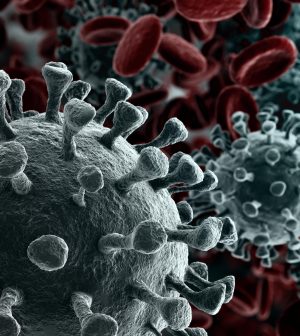- Skip Storing This Everyday Product in the Fridge Door
- Green Tea + B3 Pairing May Boost Brain Health
- Navigating Your Midlife Crisis: Embracing New Possibilities
- City Raccoons Showing Signs of Domestication
- Mapping the Exposome: Science Broadens Focus to Environmental Disease Triggers
- One Week Less on Social Media Linked to Better Mental Health
- Your Brain Changes in Stages as You Age, Study Finds
- Some Suicide Victims Show No Typical Warning Signs, Study Finds
- ByHeart Formula Faces Lawsuits After Babies Sickened With Botulism
- Switch to Vegan Diet Could Cut Your Greenhouse Gas Emissions in Half
New COVID Variant Takes Hold in the United States

TUESDAY, Nov. 28, 2023 (Healthday News) — The prevalence of a highly mutated COVID variant has tripled in the past two weeks, new government data shows.
Now, nearly 1 in 10 new COVID cases are fueled by the BA.2.86 variant, the U.S. Centers for Disease Control and Prevention reported Monday.
The variant is spreading the fastest in the Northeast: Just over 13% of cases in the New York and New Jersey region are blamed on BA.2.86.
Scientists first warned of the highly mutated variant back in August, but it has since spread in several regions of the United States.
Until now, the vast majority of new COVID cases have been blamed on the XBB variant and several of its descendants, including the HV.1 and EG.5 variants.
But that may soon change.
The CDC’s estimates carry wide margins of error around BA.2.86’s prevalence, but the latest estimate is triple what it was on Nov. 11, the data showed.
Still, “it is important to note that early projections tend to be less reliable, since they depend on examining growth trends of a smaller number of sequences, especially as laboratory-based testing volume for SARS-CoV-2 has decreased substantially over time,” the agency noted in an update on the variant.
So far, preliminary data on the variant suggests it does not trigger more severe illness than previous variants, the WHO said in a recent risk evaluation, but the international agency still noted a recent and “substantial rise” in BA.2.86 cases.
The CDC also noted that BA.2.86 variant poses a “low” public health risk.
But the CDC data released Monday did show that emergency department visits linked to COVID-19 have begun to climb nationwide.
One particular descendant of BA.2.86 might be driving the increase, experts say.
In recent weeks, scientists have been studying a steep increase in a BA.2.86 descendant called JN.1, which has become the fastest-growing subvariant worldwide.
“Currently, JN.1 is the most common version of BA.2.86 in the U.S. CDC projects BA.2.86 and its offshoots like JN.1 will continue to increase as a proportion of SARS-CoV-2 genomic sequences,” CDC spokesperson Jasmine Reed told CBS News.
The good news?
This season’s vaccines are expected to work against JN.1, as they do against BA.2.86, the agency said.
More information
Visit the CDC for more on COVID variants.
SOURCE: U.S. Centers for Disease Control and Prevention, Nov. 27, 2023
Source: HealthDay
Copyright © 2025 HealthDay. All rights reserved.










